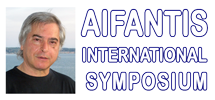Abstract:
Current strategies of computational crystal plasticity that focus on individual atoms or dislocations are impractical for real-scale, large-strain problems even with today's computing power. Dislocation-density based approaches are a way forward but most schemes published to-date give a heavier weight on the consideration of geometrically necessary dislocations (GNDs), while statistically stored dislocations (SSDs) are either ignored or treated in ad hoc manners. In reality, however, the motions of GNDs and SSDs are intricately linked through their mutual (e.g. Taylor) interactions, and in fact, GNDs and SSDs are indistinguishable on a microstructural level, notwithstanding the fact that the GNDs are simply the portion of dislocations associated with the overall shape change of the crystal. A correct scheme for dislocation dynamics should therefore be the one commonly used in discrete dislocation dynamics (DDD) simulations, namely, an "all-dislocation" treatment that is equally applicable for all dislocations comprising both the GNDs and SSDs, with a rigorous description of the interactions between them.
In this paper, a new scheme for computational dynamics of dislocation-density functions, based on the above "all-dislocation" principle, is discussed. The dynamic evolution laws for the dislocation densities are derived by coarse-graining the individual density vector fields of all the discrete dislocation lines in the system, without distinguishing between GNDs and SSDs. The mutual elastic interactions between dislocations are treated in full by generalizing the elastic interactions between dislocation segments for dislocation densities, and reducing the Hirth-Lothe line-integral formulation into an algebraic form comprising only elementary functions which are straightforward enough for efficient numerical implementation. Other features in the model include forest (Taylor) hardening, generation due to the connectivity nature of dislocations, and dipole annihilation. Numerical implementation is by means of the finite volume method (FVM), which is well suited for high gradients often encountered in dislocation plasticity.
As a first case study, the model is utilized to predict vibration-induced softening and dislocation pattern formation experimentally observed in crystalline metals. The simulations reveal the main mechanism for subcell formation under oscillatory loadings to be the enhanced elimination of SSDs by the oscillatory stress, leaving behind GNDs with low Schmid factors which then form the subgrain walls. The depletion of the SSDs also accounts for the softening, and this occurs because the oscillatory loading brings reversals into the motions of SSDs which then increase their chance of meeting up and annihilation. This is the first simulation effort to successfully predict the cell formation phenomenon under vibratory loadings, and this example highlights the importance of a rigorous "all-dislocation" treatment since both the SSDs and GNDs have significant roles to play.
A second case study concerns size effects in crystal plasticity. The new model is found capable of capturing a number of key experimental features including the Hall-Petch relation in polycrystalline states, and power-law relation between strength and size in micro-crystals. In the former, dislocation pile-ups at grain boundaries, and in the latter case, low dislocation storage and jerky deformation, are predicted.
|








